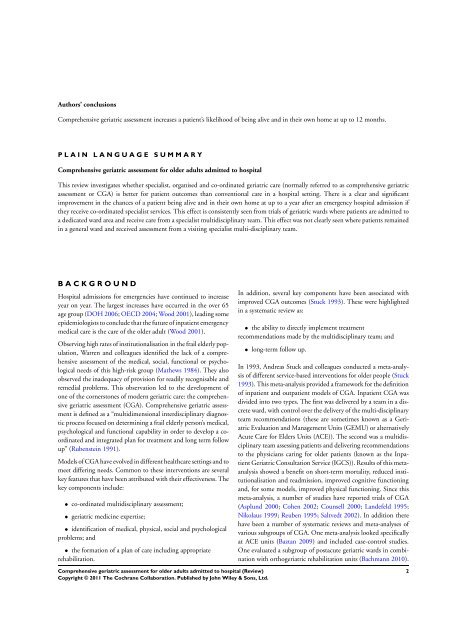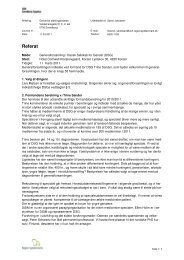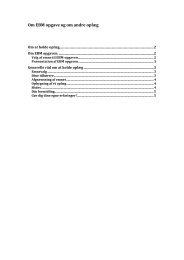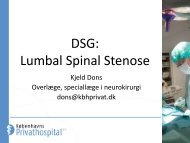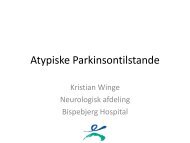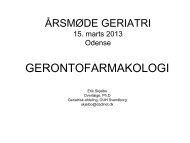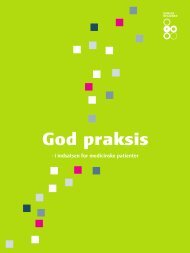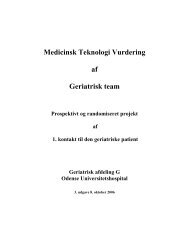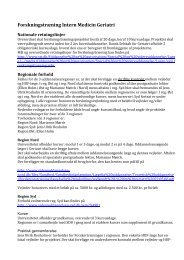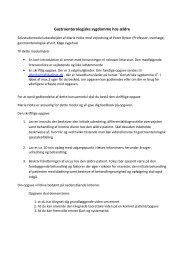Comprehensive geriatric assessment for older adults admitted to ...
Comprehensive geriatric assessment for older adults admitted to ...
Comprehensive geriatric assessment for older adults admitted to ...
Create successful ePaper yourself
Turn your PDF publications into a flip-book with our unique Google optimized e-Paper software.
Authors’ conclusions<br />
<strong>Comprehensive</strong> <strong>geriatric</strong> <strong>assessment</strong> increases a patient’s likelihood of being alive and in their own home at up <strong>to</strong> 12 months.<br />
P L A I N L A N G U A G E S U M M A R Y<br />
<strong>Comprehensive</strong> <strong>geriatric</strong> <strong>assessment</strong> <strong>for</strong> <strong>older</strong> <strong>adults</strong> <strong>admitted</strong> <strong>to</strong> hospital<br />
This review investigates whether specialist, organised and co-ordinated <strong>geriatric</strong> care (normally referred <strong>to</strong> as comprehensive <strong>geriatric</strong><br />
<strong>assessment</strong> or CGA) is better <strong>for</strong> patient outcomes than conventional care in a hospital setting. There is a clear and significant<br />
improvement in the chances of a patient being alive and in their own home at up <strong>to</strong> a year after an emergency hospital admission if<br />
they receive co-ordinated specialist services. This effect is consistently seen from trials of <strong>geriatric</strong> wards where patients are <strong>admitted</strong> <strong>to</strong><br />
a dedicated ward area and receive care from a specialist multidisciplinary team. This effect was not clearly seen where patients remained<br />
in a general ward and received <strong>assessment</strong> from a visiting specialist multi-disciplinary team.<br />
B A C K G R O U N D<br />
Hospital admissions <strong>for</strong> emergencies have continued <strong>to</strong> increase<br />
year on year. The largest increases have occurred in the over 65<br />
age group (DOH 2006; OECD 2004; Wood 2001), leading some<br />
epidemiologists <strong>to</strong> conclude that the future of inpatient emergency<br />
medical care is the care of the <strong>older</strong> adult (Wood 2001).<br />
Observing high rates of institutionalisation in the frail elderly population,<br />
Warren and colleagues identified the lack of a comprehensive<br />
<strong>assessment</strong> of the medical, social, functional or psychological<br />
needs of this high-risk group (Mathews 1984). They also<br />
observed the inadequacy of provision <strong>for</strong> readily recognisable and<br />
remedial problems. This observation led <strong>to</strong> the development of<br />
one of the corners<strong>to</strong>nes of modern <strong>geriatric</strong> care: the comprehensive<br />
<strong>geriatric</strong> <strong>assessment</strong> (CGA). <strong>Comprehensive</strong> <strong>geriatric</strong> <strong>assessment</strong><br />
is defined as a “multidimensional interdisciplinary diagnostic<br />
process focused on determining a frail elderly person’s medical,<br />
psychological and functional capability in order <strong>to</strong> develop a coordinated<br />
and integrated plan <strong>for</strong> treatment and long term follow<br />
up” (Rubenstein 1991).<br />
Models of CGA have evolved in different healthcare settings and <strong>to</strong><br />
meet differing needs. Common <strong>to</strong> these interventions are several<br />
key features that have been attributed with their effectiveness. The<br />
key components include:<br />
• co-ordinated multidisciplinary <strong>assessment</strong>;<br />
• <strong>geriatric</strong> medicine expertise;<br />
• identification of medical, physical, social and psychological<br />
problems; and<br />
• the <strong>for</strong>mation of a plan of care including appropriate<br />
rehabilitation.<br />
<strong>Comprehensive</strong> <strong>geriatric</strong> <strong>assessment</strong> <strong>for</strong> <strong>older</strong> <strong>adults</strong> <strong>admitted</strong> <strong>to</strong> hospital (Review)<br />
Copyright © 2011 The Cochrane Collaboration. Published by John Wiley & Sons, Ltd.<br />
In addition, several key components have been associated with<br />
improved CGA outcomes (Stuck 1993). These were highlighted<br />
in a systematic review as:<br />
• the ability <strong>to</strong> directly implement treatment<br />
recommendations made by the multidisciplinary team; and<br />
• long-term follow up.<br />
In 1993, Andreas Stuck and colleagues conducted a meta-analysis<br />
of different service-based interventions <strong>for</strong> <strong>older</strong> people (Stuck<br />
1993). This meta-analysis provided a framework <strong>for</strong> the definition<br />
of inpatient and outpatient models of CGA. Inpatient CGA was<br />
divided in<strong>to</strong> two types. The first was delivered by a team in a discrete<br />
ward, with control over the delivery of the multi-disciplinary<br />
team recommendations (these are sometimes known as a Geriatric<br />
Evaluation and Management Units (GEMU) or alternatively<br />
Acute Care <strong>for</strong> Elders Units (ACE)). The second was a multidisciplinary<br />
team assessing patients and delivering recommendations<br />
<strong>to</strong> the physicians caring <strong>for</strong> <strong>older</strong> patients (known as the Inpatient<br />
Geriatric Consultation Service (IGCS)). Results of this metaanalysis<br />
showed a benefit on short-term mortality, reduced institutionalisation<br />
and readmission, improved cognitive functioning<br />
and, <strong>for</strong> some models, improved physical functioning. Since this<br />
meta-analysis, a number of studies have reported trials of CGA<br />
(Asplund 2000; Cohen 2002; Counsell 2000; Landefeld 1995;<br />
Nikolaus 1999; Reuben 1995; Saltvedt 2002). In addition there<br />
have been a number of systematic reviews and meta-analyses of<br />
various subgroups of CGA. One meta-analysis looked specifically<br />
at ACE units (Baztan 2009) and included case-control studies.<br />
One evaluated a subgroup of postacute <strong>geriatric</strong> wards in combination<br />
with ortho<strong>geriatric</strong> rehabilitation units (Bachmann 2010).<br />
2


